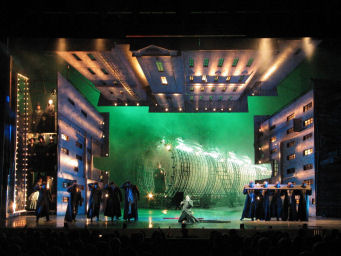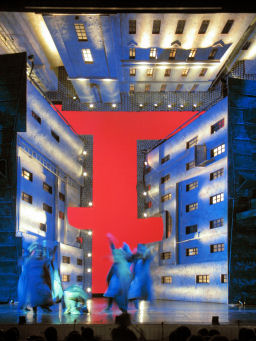|
Editorial Board
Melanie
Eskenazi
Webmaster: Len Mullenger
|
Seen and Heard Opera Review
Shostakovich: The Nose Soloists, Chorus and Orchestra of the Mariinsky Opera and Artists of the Mariinsky Ballet, Valery Gergiev (conductor) English National Opera, Coliseum, 20.07.2006 (AO)
Cast Sergey Skorokhodov: Kovalevís footman Larissa Shevchenko:Pelageya Grigorvina Podtochina Larissa Shevchenko: her daughter
Andrei Popov: a
district constable
Direction
The Nose is based on a play by Gogol. A man wakes up to find his nose has disappeared: for him, appearance means status, but the nose has different ideas. It takes on its own life, running around town as a civic official. But even thatís not clear Ė sometimes itís a body in a stretchy white shroud, sometimes itís a piece of droopy rubber, and sometimes itís not visible at all, and only spoken about. Itís a vehicle for riotous farce. An obvious target is bureaucracy: when Kovalev tries to put an advertisement in the newspaper ďlost and foundĒ itís refused on circuitous grounds. There are many other explicit send -ups, but dwelling on them would miss the panoramic vision of the piece. Vignettes fly by at a hectic pace: the bagel seller who gets raped, the Downs Syndrome twins, the old dowager announcing her own death to a bunch of twitching, neurotic spinsters. Nothingís explained: logic means little in this fertile procession of observations. At the end a Prince on a stuffed camel proclaims everythingís sorted, but by then itís obvious that weíre in the heart of mayhem, complete with banners of newsprint proclaiming HOC and COH, which I understand are wordplays on the Cyrillic for ďnoseĒ.
The apocalyptic panorama works without mishap because the performers are superlative. Dance here isnít merely decorative; itís an essential part of the staging. For example, numerous cab drivers whirl about in frantic circles, each with a fascinating passenger within, yet the maelstrom is executed with such precision that it is an integral part of the drama itself. The crowd scenes are more sophisticated than would be the norm for an opera house chorus. Itís clear these are highly trained dancers, not singers. They can hold ensemble beautifully, such as when the cab drivers lift people above their shoulders Ė the dancers at the fringe of the group donít touch, but lean and move with the otherís bodies as if they were all one single organism. When Kovalev wrestles with his Nose (in the shrouded figure of Avgust Arnonov, clearly a star dancer) they are dancing an exquisite, if strange, pas de deux. The Nose has the more difficult movements, back flipping over Kovalev, but itís done so well that the singer seems to be dancing too. It was striking, too, how much this production owed to the Russian circus tradition. Of course there were clowns, but the real influence is deeper. Circus works because thereís so much happening, so fast, that the illusion is even more spectacular than whatís actually happening. Hence the highly coloured costumes, and the almost acrobatic physicality of the performersí movements on stage. Even the massive metal tunnel (vaguely resembling a nose) creates a vast new dimension to the set, further blurring the boundaries of linear perspective. At one point an angel vocalises wordlessly from the rafters, while a sinister dark angel flits out from behind her. Circus extends the limits of what the human body can do Ė just as the errant nose amply demonstrates. Circus and opera both have the same goal: the creation of illusion. It feels almost meagre to return to the music, but that, too was dazzling. Vladislav Sulimsky, as Kovalev, is powerfully charismatic, even though heís portraying a pretentious figure who canít function when things change. He holds the production together. Yet there was superlative singing in the vignettes, too. Olga Markova-Mikhaelenko, as the old lady who predicts her death had a beautifully rich, rounded contralto which gave her portrayal a depth of characterisation not evident in the score. The advertising official, sung by Ilya Bannick, is maddeningly convincing. It was no surprise he received specially raucous applause.A number of individuals seemed to play multiple roles, which must have been a feat. Itís almost unfair to single out good performances, such were the high standards here. But the orchestra needs praise, too. Gergiev clearly enjoys this opera, and conducted it with panache, relishing the high speed action reflected in the music as well as on stage. There were fine vignettes here, too, a lovely oboe solo and some very fine trumpet playing. The angular, almost violently discordant music made it clear that, under the spectacular effects and zany humour, the Nose has dark Grand Guignol roots.
Anne Ozorio
Back to the Top Back to the Index Page |
| ||
|
||||




